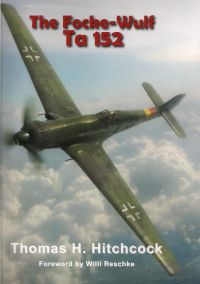
The Focke-Wulf Ta 152
by Thomas H. Hitchcock
Hardbound, 9.2" x 12.1" x 1.0", 208 pages
ISBN-13: 978-0-914144-533
Eagle Editions Ltd. (2012)
Recommended Retail Price: US $75.00
Pictures and Diagrams (see review)
Book Reviews 6
 |
The Focke-Wulf Ta 152 Hardbound, 9.2" x 12.1" x 1.0", 208 pages Recommended Retail Price: US $75.00 Pictures and Diagrams (see review) |
Reviewed by Tom Fey - 6 Jul 2016
Thomas Hitchcock has produced a fantastic, large format, high paper quality, three pound, 208 page book about the German Ta 152 high altitude fighters developed late in WWII. The research and documentation are peerless, including 51 original Focke-Wulf drawings of the airframe and sub-assemblies, 29 photographs of the several types of engines used or proposed for the Ta 152 series of aircraft, and 21 engine drawings. There are four appendices detailing 1) camouflage and markings, 2) production, 3) specifications, weights, performance and equipment, and 4) pilot operating instructions.
Hitchcock has acquired first person descriptions of flying and fighting in the Ta 152, and masterfully traces its complicated development and its ultimate, limited entry into combat during the spring of 1945. There are also period and modern color photographs of the lone surviving Ta 152H-0 held unrestored in the collection of the Smithsonian National Air and Space Museum. With 180 photographs overall, 40 color photographs, 36 color illustrations, and 19 tables and charts, there is something for everybody, especially the technically-minded devotees of the Aircraft Engine Historical Society. I cannot say enough about the depth of subject detail, astounding research, excellence and clarity of writing, and physical quality of the book itself. At 36 cents per page, it seems expensive, but in my opinion, it is a bargain.
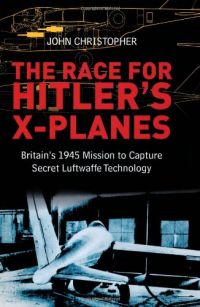 |
The Race for Hitler’s X-Planes Hardcover, 9.8" x 6.9" x 0.7", 224 pages Recommended Retail Price: £20.00 160 B/W, color illustrations |
Reviewed by Tom Fey - 5 March 2015
While AEHS readers may be familiar with the American Operation Lusty in which teams of American investigators and pilots scoured Germany and once-occupied countries to collect German aviation technology, many may not be familiar with the British initiative led by Sir Roy Fedden in June and July of 1945.
The author skillfully uses the Fedden Report itself to detail the search for documents, research reports, and production techniques as well as the aircraft, missiles, and high tech hardware. Fedden lead a team of British experts to several major research and production centers of German aviation and advanced weaponry. These sites included the sprawling Aviation Research Institute Hermann Göring complex at Völkenrode, the laboratories at Göttingen, Messerschmitt’s research and development center at Oberammergau, and multiple sites for the design and production of both BMW and Junkers. The primary target was cutting-edge aerial warfare technology; however they also sought information on piston engines, the dispersal of aircraft production, wind tunnels, and the successes/failures of the Allied wartime strategy. An essential component of the investigation was interviewing the directors, scientists, managers, and staff of the sites.
One of the satisfying strengths of this book is the association of German identities with particular technologies, designs, or aeronautical research subjects. Having this information provides leads to further research into the history, activities, and accomplishments of war-era German scientists. There is also a reasonable amount of technical detail to be found, such as the basic fuel compositions for the myriad rocket projects the Germans had under development, or what the relative material and labor costs that were required to build a BMW 801 radial or Junkers 004 jet engine. The human cost of this production is described and acknowledged by the author.
Rocket systems such as the Hs 117 Schmetterling, Wasserfall, Rheintocher, Fuerlille, HS 299, Rheinbote, and Enzian are discussed in refreshing detail alongside more famous weapon systems such as the Fritz-X, Hs 293, V1, V2, jet, and rocket aircraft.
The British got a late start to collecting German technology, and many of the sites had been picked-over by the Americans before the British team arrived. In some cases, only quick trips could be made to sites before being turned over to the French or Russians as agreed by the Potsdam Conference. Often times factories of interest were found pummeled to dust by allied bombing, leaving little to be discovered, or key staff were missing or unavailable.
Throughout the book, Fedden is quoted from his own report, giving an interesting glimpse into the man. A ten page epilogue deals with Fedden and his post war career, including his foray into automotive design.
The pictures were well chosen and nicely reproduced. I could find only a few errors (Curtiss P-60A Shooting Star? An aerial closing speed of 100 mph is excessive? Cyclic rate of the Argus pulse jet: 50 times per minute?), however these did not detract significantly from the value and enjoyment of this highly recommended book.
 |
A Technical & Operational Hardcover, 8.5" x 11", 616 pages Recommended Retail Price: US $74.95 1058 photos, drawings, charts, and diagrams |
Reviewed by Doug Culy
Those acquainted with Robert J. Neal's two books on Packard engines will see that he has found an even richer lode of data on the Liberty engine. Mining this source has been a prodigious effort, as A Technical and Operational History of the Liberty Engine is full of large, clear pictures, data tables, charts, handbook illustrations, and information gleaned from the deepest recesses of long-forgotten files.
The reader of this book is plied with stories taken from WWI Air Production Board files, US Air Service files, Packard files, Hall-Scott files, those of the other producers of the Liberty engine, and myriad other users of the engine. Included are photos, tables, and some cases, stories of every airframe, tank, and boat the engines were used in.
The reader learns that there was not just one Liberty engine model, there were two-, four-, six-, eight-, and twelve-cylinder production versions, geared and un-geared variants, one with two crankshafts, and most interestingly, there were modifications by other manufacturers.
Several different types of superchargers were applied after WWI. Allison remanufactured the engine for air cooling, and for inverted operation.
Some boat users made major head and valve-gear changes to improve the power output of engine.
Russia reverse-engineered their own version, and Britain officially produced (almost re-developed to ruggedize) the engine for tank use with different and additional accessories.
Liberty engines were regularly flown or driven until 1960 (a few are still operational), for a 43-year life cycle; there are about 43 hours of reading in this most enjoyable book. It is well worth its price.

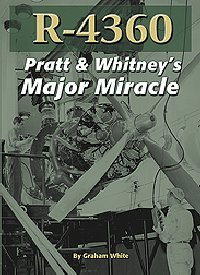 |
R-4360: Pratt & Whitney's Major Miracle Hardbound, 7.5" x 10.5", 608 pages List Price US $64.95 Over 600 pictures and drawings |
Review by Doug Culy
With this excellent work on the largest production aircraft piston engine, Graham White continues to create greater masterpieces of aircraft engine history with each succeeding effort. For the technically inclined, this book provides a surfeit of data on each model produced and not produced. This includes engine rating details, development program details (including many discussions throughout the book of problems in designing, developing, and producing the engine), and good discussions of each application of the engine. The visual delights of R-4360 include an outstanding array of photographs of all models, the airframes they powered (including the racers), most of the engine parts, thorough discussions of the controls and accessories, and many sketches, drawings, and cross-sections to illustrate details. With over 600 pages, it is an excellent buy. For the perfectionists, there are a few places in the book that are not quite right, and this reviewer challenges the readers to find them.
Review by Jukka Juutinen
Doug Culy beat me to it and got in the first review. However, I believe a second opinion isn't futile at all. For tech specs of the book, I have nothing to add to Doug's review.
This is Graham's 3rd book to be published and in many ways the best. Content wise, his R-2800 book comes close and as that engine is probably of more interest to most enthusiasts that book is likely to attract greatest interest.
However, those who have seen his first two books are in for a major surprise. As Graham's columns testify, he has a new publisher. This is, honestly speaking, a true blessing as basically every aspect of book design and layout has leapt forward by huge steps. Gone is the very clumsy single column layout. Gone is the poor paper best suited for certain domestic purposes. The new book is both a pleasure to handle and pleasant to the eye.
Basically the book follows the path set by his R-2800 book, i.e. the engine background is discussed first followed by descriptions of various parts and systems, variants, military and civilian applications ending with a sort of retrospective with operator accounts. What I liked a lot is the considerable space given to less produced aircraft like the Hughes Hercules. That chapter has plenty of interesting material I have never seen elsewhere.
There are also a couple of things I find annoying. I personally prefer numerical reference noting (i.e. footnoting with a simple numeral) instead of the system Graham uses (e.g., "Ref.7.3.") as the latter takes up more space and is more conspicuous to the eye. Another point is the excessive crediting of illustrations. I find it is extremely clumsy to say "Courtesy of National Archives & Records Administration" when simple "NARA" or "National Archives" would do. In fact, I checked the B-36 book from the same publisher and indeed that book uses the better, more condensed crediting. And for non-US readers metric conversions in the text and especially the tables would have been most useful. There a few misprints. Perhaps the most annoying is the "horespower" (sic!) in one graph.
Reading the book raised a few points that I have previously suspected. First, how much easier a liquid cooled engine would have been to install in especially large aircraft requiring pusher and/or buried installation. Second, how crude US attempts at direct injection systems were. The description of the Bendix system reveals how far behind that system was behind, e.g. the German Bosch system. For example, the injection pressure provided by the Bosch pump was much greater (500 psi versus over 2,100 psi). And while this Bendix system had 3-position pilot control, Bosch system had fully automatic mixture control. Overall, the superiority of German automated engine controls is easily confirmed by a look at B-36 flight engineer duties.
I also wonder how much neater result would have been gained by employing sleeve valves. Just a look at Bristol designs reveals that. The book also discusses what might have been, i.e. how piston engines would have developed had the power requirements continued to grow. Personally, with hindsight, the best approach might have been coupled installation like in the Brabazon. I think it is realistic to assume that e.g. 2 x 2,500 hp plus gearbox would weigh the same as one 5,000 hp piston engine in a complete installation. Benefits would have been numerous. First, as the same basic engine would have been used in "smaller" and "larger" aircraft, parts supply and maintenance training would have been greatly simplified. And, being able to run only a half of the powerplant might have been a useful in some cruising conditions plus an added safety factor.
Overall, a very good book and a necessary addition to any gearhead's library.
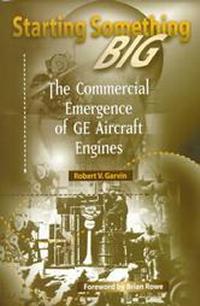 |
Starting Something Big Softbound, 23cm x 15cm, 341 pages List Price: US $37.95 |
Reviewed by Jerry Wells
Bob Garvin was born in Vienna in 1927, educated at King's College in the UK and, soon after, moved to the USA where he was employed by General Electric for the whole of his working life. He joined GE in the 1950s and was involved in the establishment of license agreements with foreign countries to manufacture the highly successful J79 military jet engine, noted, of course for its innovative variable stator technology. An indication of his importance in the GE company is the two "mentions" and one photo of him in the giant GE "corporate glossy" publication Eight Decades of Progress!
His book recounts the history of GE gas turbines from his point of view, i.e., not so much as a "hands-on" engineer but more from the commercial marketing perspective. For this reason, I nearly didn't buy the book—selling goods of any sort seldom makes riveting reading! However, this work doesn't skimp on technicalities and I found it interesting from cover to cover.
As an adjunct to the detail provided in Eight Decades of Progress, it is excellent. Garvin concentrates mainly on his field of expertise, i.e., overseas marketing. His account of the joining up of GE with SNECMA in France to coproduce the CFM-56 is particularly good. There are two long chapters on developing the Chinese and Russian markets—clearly, a very difficult enterprise.
For all this, Garvin does not leave out coverage of the marketing of GE engines in the USA. His description of getting GE engines into the Boeing 747 and of the "Great Engine War" is a credit to his writing skills and, in the latter case, when read alongside the Robert Drews booklet, The Air Force and the Great Engine War, really clarifies the situation.
So, what we have here is an interesting and lucid text which should be the basis for an excellent addition to the aero-engine literature. Something of a disappointment is that this first-class narrative is packaged and presented in what amounts to little more than a cheap-and-nasty paperback. It has only a soft cover, hard to open, glued-down-one-side binding and less than a dozen poorly reproduced photographs many of which have been used before. How can a 65-page chapter on GE in China (in which Garvin was deeply involved) not have even a single picture or map to illustrate it? Not that there is any shortage of space in the book for more or better illustrations—11 of the 341 pages are completely blank! The only appearance of colour anywhere is on the cover and that consists of two shades of brown!
The quality of this book does the author (or GE, or the AIAA) no credit at all. If it was a reprint (as with the recently reissued Herman the German by AuthorHouse 2004) it might be excusable but this is the first edition and it is hard to understand why this major work would be published as anything less than a properly bound, fully illustrated book. Regrettably and inexplicably this is an exercise in penny-pinching which is a great shame.
The book has failings but, none the less, is a "must" for the aero-engine enthusiast's library.
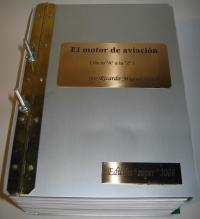 |
El motor de la aviación (De la "A" a la "Z" L'Aeroteca |
Reviewed by Kimble D. McCutcheon
This big book attempts the lofty goal of describing all aero engines ever built. Written in Spanish, it comes from Barcelona, perhaps the most important industrial center in Spain, where engines for aircraft, autos, ships, trains and trucks have been built for more than 100 years. Despite my struggles with the Spanish language, I have found it quite useful and refer to it often to cross-check aircraft engine data. On several occasions it has provided information not available from any other source.
The 2008 edition greatly expanded, with significantly more attention to gas turbines, rockets and model engines. In addition to incorporating new material and all the older revisions, the 2008 edition includes a a more expansive two-column format with additional margin space, larger photos, a new introduction, and duplex printing that reduces the weight and thickness. There are plans for an English translation. |
Mr. Vidal has, in a great act of generosity, made the entire 2008 Spanish edition (all 3,200 pages) available to AEHS members for FREE. It can be downloaded from the AEHS Member's Section.
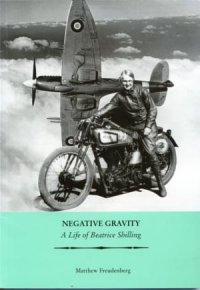 |
Negative Gravity Softbound, 136 pages |
Reviewed by Graham White
Beatrice "Tilly" Shilling is a legend in Merlin lore. It was Ms. Shilling who overcame the serious negative "G" cutout problems with SU carburetor equipped Merlins. The tale has been told many times but briefly the SU carburetor was not equipped to handle negative "G" without first starving the engine for fuel and then over compensating and drowning the engine with an over rich mixture. The solution was disarmingly simple, a restrictor orifice fitted to the fuel supply line. In a way it's too bad that Ms. Shilling's reputation at the Royal Aircraft Establishment was based on this one, albeit major, accomplishment.
Prior to WWII she was an expert motor cycle rider who participated at the famous Brooklands speedway, basically a British equivalent to the Indianapolis Motor Speedway. Unfortunately but understandably, Brooklands was demolished during WWII as it stuck out like a sore thumb and would have made an ideal navigation reference point for German bombers. The book delves into the frustration Ms. Shilling suffered for not being promoted and blamed it on her sex. Reading between the lines I got the impression that, true, she lived in a very chauvinistic time when it was rare to have female physicists running the show. However, part of the blame should have rested with Ms. Shilling. As author Matthew Freudenberg astutely pointed out, she was not what would today be known as a "power dresser", in fact she looked pretty awful. One interesting photograph in the book shows her consulting with Dan Gurney in 1967 when he was campaigning his All American Eagle Formula 1 racer. At the time his Harry Weslake designed V-12 was suffering overheating problems and Ms. Shilling was brought in as a consultant. In the photo she looked like a frumpy old British housewife with hand bag draped over her arm and yet despite this persona she was one of the most brilliant engineers of her time — fascinating.
Today, she would no doubt be regarded as politically incorrect. Exacerbating the situation for her was the fact she showed little respect for her superiors. I can certainly empathize with that attitude, however, the consequences are few or no promotions. One has to respect her single mindedness and independence because she must have surely realized that it cost her big time. If she had been a male and knew how to play the game there is no doubt she would have ended up running the RAE.
The book also explores her personal life, particularly her relationship with her husband and his WWII service as a Lancaster bomber pilot who completed 36 missions. Overall, I rate this book as an excellent read and well worth the money.